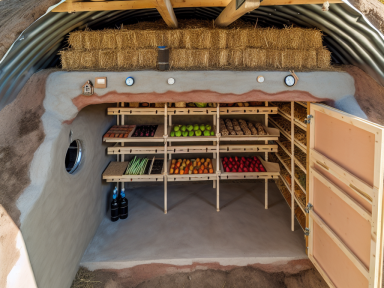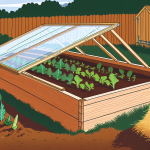Why Build a Root Cellar?
A root cellar is a time-honored method for preserving your garden’s bounty without relying on refrigeration. By maintaining a cool, stable environment, you can store vegetables, fruits, and even some meats for extended periods.
Choosing the Right Location
When selecting a site for your root cellar, consider the following:
- **North-Facing Slope:** A north-facing slope is optimal as it will naturally remain cooler.
- **Proximity:** Ensure it’s within easy travel distance from your home, especially in harsh weather.
- **Soil Drainage:** Choose a location with well-draining soil to avoid waterlogged conditions.
- **Accessibility:** Make sure that the entrance won’t be obstructed by snow or floodwaters.
Design Considerations
Size: Estimate your storage needs. A small household might need only a space of 6×8 feet, while a larger family might consider a room of 10×20 feet.
Ventilation: Proper air circulation is crucial. Install two vents: one near the floor and one near the ceiling to facilitate air movement.
Insulation: Use materials like straw bales, sawdust, or foam insulation to maintain a stable temperature.
Flooring: Natural earth floors work well because they don’t trap moisture. If you prefer, crushed stone can also be used.
Construction Steps
- Excavation: Dig out the desired space according to your planned dimensions.
- Wall Construction: Build walls with materials like concrete blocks, wood, or even bricks. Ensure they are sealed properly to prevent water seepage.
- Roof: Construct a roof sturdy enough to bear the weight of the soil and potential snow. Use materials like wood or corrugated metal, and add a waterproof layer like tar paper.
- Ventilation System: Install your ventilation pipes, ensuring one is near the ground and the other near the roof.
- Insulation: Insulate the walls and ceiling using your chosen material. This step is crucial to maintaining a constant temperature.
- Entrance: Create an insulated door. Double doors can be very effective in preventing air exchange with the outdoors.
Environmental Control
Maintaining the right environment inside your root cellar is key to effective storage.
- Temperature: Aim for a temperature range of 32-40°F (0-4°C).
- Humidity: Maintain a humidity level between 85-95%.
- Monitoring: Use a thermometer and hygrometer to regularly check conditions.
Common Storage Tips
– **Separate Fruits and Vegetables:** Some fruits (like apples) emit ethylene gas, which can cause nearby vegetables to spoil faster.
– **Proper Shelving:** Use wooden shelves as metal can rust and cold air circulates better around wood.
– **Containers:** Store produce in baskets or crates for better airflow. Avoid plastic bags as they trap moisture and can lead to rot.
– **Regular Checks:** Inspect your stores regularly for any signs of spoilage and remove affected items immediately to prevent spread.
Building and maintaining a root cellar might seem daunting, but the rewards in terms of extended, natural storage for your fresh produce are well worth the effort. With proper planning and construction, you’ll have a reliable method to preserve your garden’s bounty for months to come.



GIPHY App Key not set. Please check settings